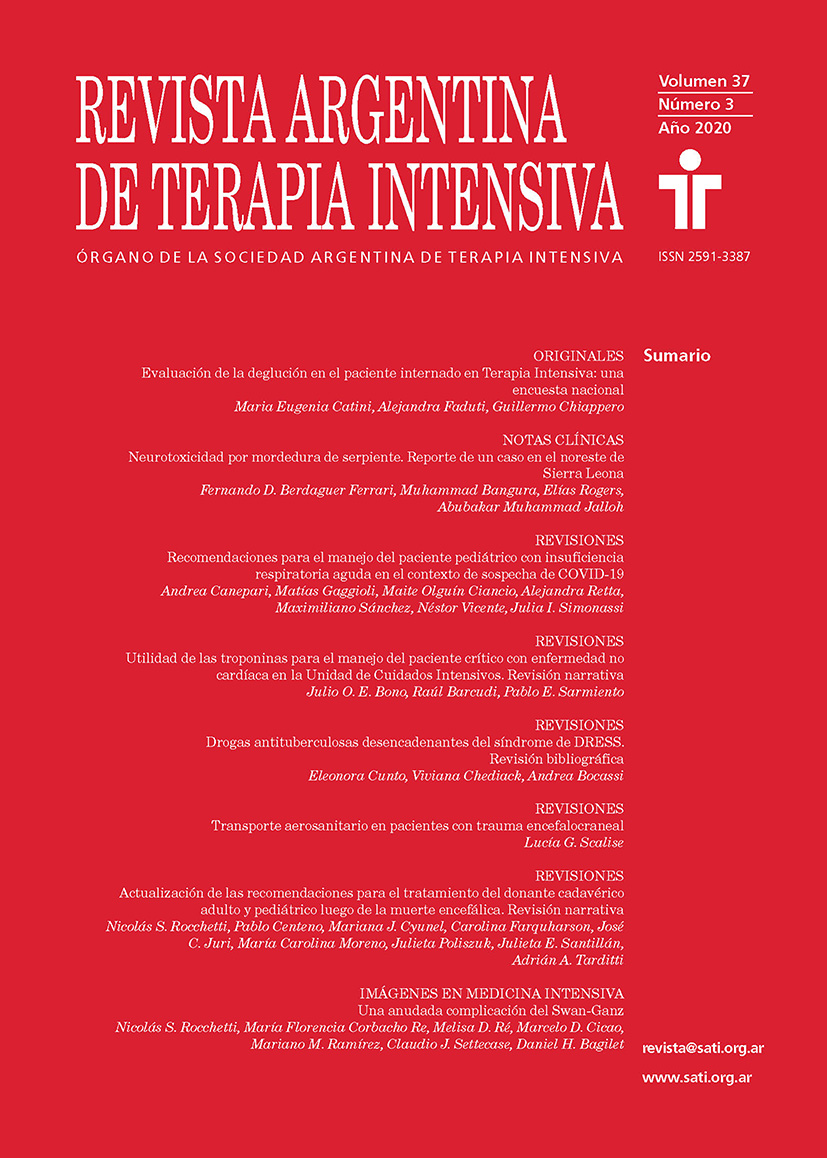Resumen
Las mordeduras de serpientes son una de las enfermedades integra el grupo de enfermedades olvidadas así declaradas por la OMS. Aún cobran vidas y producen discapacidad en una cantidad considerable de la población. Estas presentan un mayor riesgo en poblaciones de recursos limitados. Relatamos nuestra experiencia en el Sierra Leona, reflexionando a la luz de bibliografía actual, un caso de neurotoxicidad con paro respiratorio. El manejo del caso, por un equipo asistencial entrenado en medidas de soporte vital básicas, sumado al empleo de suero antiofídico, permitió la evolución favorable del paciente.
Referencias
Kasturiratne, A., Wickremasinghe, A. R., de Silva, N., Gunawardena, N. K., Pathmeswaran, A., Premaratna, R., et al. The global burden of snakebite: a literature analysis and modelling based on regional estimates of envenoming and deaths. PLoS medicine. 2008;5(11), e218. https://doi.org/10.1371/journal.pmed.0050218.
Williams, D., Gutiérrez, J. M., Harrison, R., Warrell, D. A., White, J., Winkel, K. D., & Gopalakrishnakone, P. The Global Snake Bite Initiative: an antidote for snake bite. The lancet. 2010;375(9708), 89-91. https://doi.org/10.1016/S0140-6736(09)61159-4.
Warrell, D. A. Snake bite. The lancet 2010;375(9708), 77-88. https://doi.org/10.1016/S0140-6736(09)61754-2.
Menzies, J.I. The snakes of Sierra Leone. Copeia, 1966, p. 169-179.
Médicos sin fronteras. Las reservas de antÃdotos para las mordeduras de serpiente se agotan. 08/09/2015. https://www.msf.es/actualidad/las-reservas-antidotos-las-mordeduras-serpiente-se-agotan. Ultimo acceso 09/12/19.
Médicos sin fronteras. Sin antÃdotos para tratar las mordeduras de serpiente. 03/06/2016. https://www.msf.es/actualidad/sudan-del-sur/antidotos-tratar-las-mordeduras-serpiente. Ultimo acceso 09/12/19.
Alirol, E., Lechevalier, P., Zamatto, F., Chappuis, F., Alcoba, G., Potet, J. Antivenoms for snakebite envenoming: what is in the research pipeline?. PLoS neglected tropical diseases. 2015;9(9), e0003896. https://doi.org/10.1371/journal.pntd.0003896.
Médicos Sin Fronteras. Snake bite management. Update 2016. Documento interno.
Brunda, G., Sashidhar, R. B. Epidemiological profile of snake-bite cases from Andhra Pradesh using immunoanalytical approach. Indian journal of medical research. 2007;125(5), 661. https://www.researchgate.net/profile/Brunda_Ganneru/publication/6195118_Epidemiological_profile_of_snake-bite_cases_from_Andhra_Pradesh_using_immunoanalytical_approach/links/557fa18c08aec87640de00a4.pdf. Ultimo acceso 09/12/19.
Sharma, S. K., Chappuis, F., Jha, N., Bovier, P. A., Loutan, L., Koirala, S. Impact of snake bites and determinants of fatal outcomes in southeastern Nepal. The American journal of tropical medicine and hygiene. 2004;71(2), 234-238. https://doi.org/10.4269/ajtmh.2004.71.234.
Currie, B. J., Smith, A. M., Sutherland, S. K., Hudson, B. J. An epidemiological study of snake bite envenomation in Papua New Guinea. Medical journal of Australia. 1991;154(4), 266-268. https://doi.org/10.5694/j.1326-5377.1991.tb121088.x.
Thaddeus, S., Maine, D. Too far to walk: maternal mortality in context. Social science & medicine. 1994;38(8), 1091-1110.
World Health Organisation. Venomous snakes distribution and species risk categories. http://apps.who.int/bloodproducts/snakeantivenoms/database/ (Ultimo acceso 09/12/19).
Silva, A., Hodgson, W. C., & Isbister, G. K. Antivenom for neuromuscular paralysis resulting from snake envenoming. Toxins. 2017;9(4), 143. https://doi.org/10.3390/toxins9040143.
Dörges, V. Airway management in emergency situations. Best Practice & Research Clinical Anaesthesiology. 2005;19(4), 699-715. https://doi.org/10.1016/j.bpa.2005.07.003.
World Health Organisation. Guidelines for the prevention and clinical management of snakebite in Africa. 2010. http://apps.who.int/medicinedocs/en/m/abstract/Js17810en/ Ultimo acceso 09/12/19.
Wright, S., Haddock, G. Achieving Full Neurological Recovery in Snakebite using Best Supportive Care. Case Reports. 2018; bcr-2017. http://dx.doi.org/10.1136/bcr-2017-223765.
Schweitz, H., Vigne, P., Moinier, D., Frelin, C., Lazdunski, M. A new member of the natriuretic peptide family is present in the venom of the green mamba (Dendroaspis angusticeps). Journal of Biological Chemistry. 1992;267(20), 13928-13932. http://www.jbc.org/content/267/20/13928.short Ultimo acceso 09/12/19.
Lisy, O., Jougasaki, M., Heublein, D. M., Schirger, J. A., Chen, H. H., Wennberg, P. W., Burnett, J. C. Renal actions of synthetic dendroaspis natriuretic peptide. Kidney international 1999;56(2), 502-508. https://doi.org/10.1046/j.1523-1755.1999.00573.x.
Singh, G., Kuc, R. E., Maguire, J. J., Fidock, M., Davenport, A. P. Novel snake venom ligand dendroaspis natriuretic peptide is selective for natriuretic peptide receptor-A in human heart: downregulation of natriuretic peptide receptor-A in heart failure. Circulation research. 2006;99(2), 183-190. https://doi.org/10.1161/01.RES.0000232322.06633.d3
La revista no retiene los derechos de reproducción (copyright) por lo que los autores pueden volver a publicar sus trabajos con la sola mención a la fuente original de publicación.

